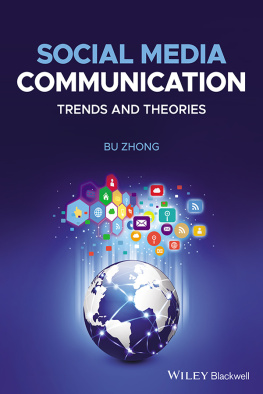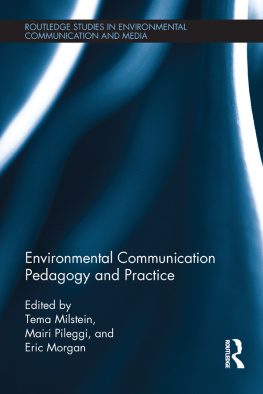Reimagining Communication: Mediation
Reimagining Communication: Mediation explores information and media technologies across a variety of contemporary platforms, uses, content variations, audiences, and professional roles.
A diverse body of contributions in this unique interdisciplinary resource offers perspectives on digital games, social media, photography, and more. The volume is organized to reflect a pedagogical approach of carefully laddered and sequenced topics, which supports experiential, project-based learning in addition to a courses traditional writing requirements. As the field of Communication Studies has been continuously growing and reaching new horizons, this volume synthesizes the complex relationship of communication to media technologies and its forms in a uniquely accessible and engaging way.
This is an essential introductory text for advanced undergraduate and graduate students and scholars of communication, broadcast media, and interactive technologies, with an interdisciplinary focus and an emphasis on the integration of new technologies.
Michael Filimowicz, PhD, is Senior Lecturer in the School of Interactive Arts and Technology at Simon Fraser University. His research is in the area of computer mediated communication, with a focus on new media poetics applied in the development of new immersive audiovisual displays for simulations, exhibition, games, and telepresence as well as research creation.
Veronika Tzankova is a PhD candidate in the School of Interactive Arts and Technology, Simon Fraser University and a Communications Instructor at Columbia College both in Vancouver, Canada. Her background is in humancomputer interaction and communication. Sport shapes the essence of her research which explores the potential of interactive technologies to enhance bodily awareness in high-risk sports activities.
First published 2020
by Routledge
52 Vanderbilt Avenue, New York, NY 10017
and by Routledge
2 Park Square, Milton Park, Abingdon, Oxon OX14 4RN
Routledge is an imprint of the Taylor & Francis Group, an informa business
2020 selection and editorial matter, Michael Filimowicz and Veronika Tzankova; individual chapters, the contributors.
The right of Michael Filimowicz and Veronika Tzankova to be identified as the authors of the editorial material, and of the authors for their individual chapters, has been asserted in accordance with sections 77 and 78 of the Copyright, Designs and Patents Act 1988.
All rights reserved. No part of this book may be reprinted or reproduced or utilized in any form or by any electronic, mechanical, or other means, now known or hereafter invented, including photocopying and recording, or in any information storage or retrieval system, without permission in writing from the publishers.
Trademark notice: Product or corporate names may be trademarks or registered trademarks, and are used only for identification and explanation without intent to infringe.
British Library Cataloguing-in-Publication Data
A catalogue record for this book is available from the British Library
Library of Congress Cataloging-in-Publication Data
Names: Filimowicz, Michael, editor. | Tzankova, Veronika, editor.
Title: Reimagining communication : mediation / edited by Michael Filimowicz and Veronika Tzankova.
Other titles: Mediation
Description: Abingdon, Oxon ; New York, NY : Routledge, 2020. | Includes bibliographical references and index. |
Summary: Reimagining Communication: Mediation explores information and media technologies across a variety of contemporary platforms, uses, content variations, audiences, and professional roles Provided by publisher.
Identifiers: LCCN 2019051300 (print) | LCCN 2019051301 (ebook) |ISBN 9781138498907 (hardback) | ISBN 9781138498914 (paperback) |ISBN 9781351015431 (ebook) | ISBN 9781351015424 (adobe pdf) |ISBN 9781351015417 (epub) | ISBN 9781351015400 (mobi)
Subjects: LCSH: Communication and technology. | CommunicationTechnological innovations. | Digital media.
Classification: LCC P96.T42 R45 2020 (print) |LCC P96.T42 (ebook) | DDC 302.23dc23
LC record available at https://lccn.loc.gov/2019051300
LC ebook record available at https://lccn.loc.gov/2019051301
ISBN: 978-1-138-49890-7 (hbk)
ISBN: 978-1-138-49891-4 (pbk)
ISBN: 978-1-351-01543-1 (ebk)
In an age of information overflow, the word communication seems to have reached a buzz-status. From persuasive communication, to the importance of good communication, to communication skills for bridging gaps, the term and domain of communication has become increasingly obscure and even confusing. We see this confusion reflected in students on introductory communication courses. Their initial understanding of communication often tends to focus on linguistic exchanges between individuals, not accounting for the wide range of personal, social, and contextual dynamics that influence not only the transfer of information, but also the complex processes of meaning-making at individual and collective levels. Where initial conceptualizations of communication have focused on information-transfers between senders and receivers, contemporary scholarship seems to apply a much broader, and to an extent, a pragmatically-informed approach looking not only at how communication practices work, but also how these shape the ways in which we make sense of the reality that surrounds us.
Partially due to the wide range of perspectives and approaches, the field of communication studies still lacks distinctive disciplinary boundaries. When we think of traditional academic fieldssuch as biology, sociology, philosophy, and mathematics, for examplewe know with some degree of certainty what the object of study is. When it comes to the field of communication however, we realize that establishing a definitive scholastic focus is not easy, if not impossible. This is to an extent related to the challenges associated with answering a fundamental, and seemingly simple question: What is communication? As an all-encompassing answer to this question we should be able to account for all of the situations, exchanges, contexts, interpretations, channels and any possible mix of these, we can see that this can easily become a hopeless task. In an attempt to resolve this complexity, scholars have emphasized different sides of communication processes which have influenced the development of a multiplicity of material, functional, and experiential definitions. Most definitions revolve around one of the following categorical characteristics of communication: (1) transfer of information, (2) symbolic culture, and (3) a ritual which facilitates the inherent social essence of humanity (see Carey, 2009). These varying types of exegesis pose fundamental challenges in defining and delimiting the concept and disciplinary boundaries of communication. Within such expanding views, the purpose of the Reimagining Communication series is to capture the existing and prospective trends and perspectives on and within communications studies as a whole. To systematize our approach, we have provided a specific theme for each of our volumes: Meaning, Experience, Action, and Mediation. Each of these volumes extends on the existing notions and scholarship within the field of communication, in order to captureas much as possiblethe main contexts, communication technologies, institutions, and social practices.
These volumes construct a new information architecture which reimagines a new organization for traditional and emerging themes in communication studies. To describe our editorial project, we appropriate the concept of information architecture (hereafter IA) from the domain of human-information interaction. The notion of IAas opposed to the commonly used map or frameworkhighlights the constructed character of the series as a work of design, and as one design solution out of many possible others. We have decided to redesign and reimagine the field of fields and disciplines of communication through a forward-looking multidisciplinary lens which has its grounding in both established academic scholarship and developing domains focusing on the latest technological developments.









